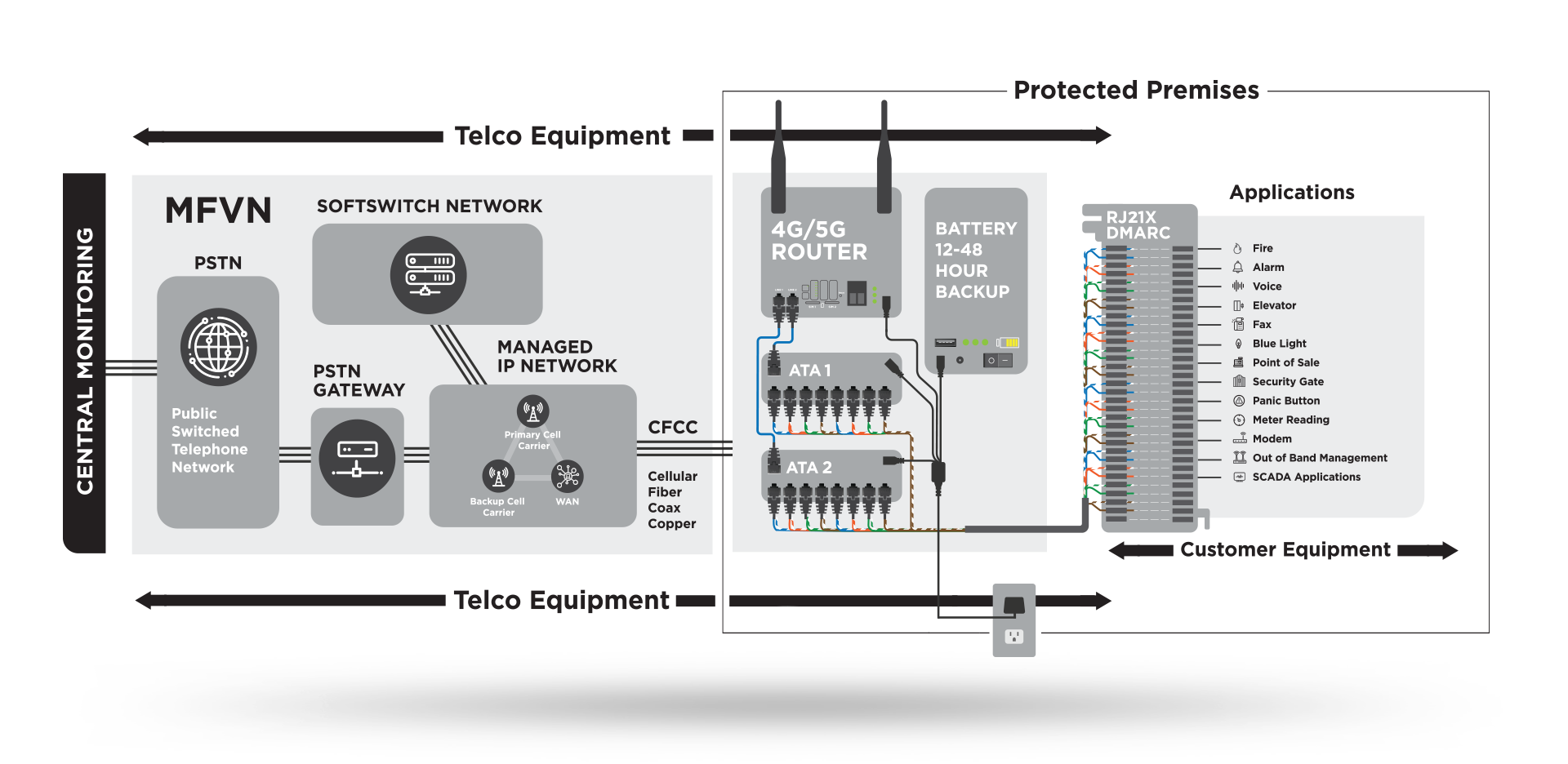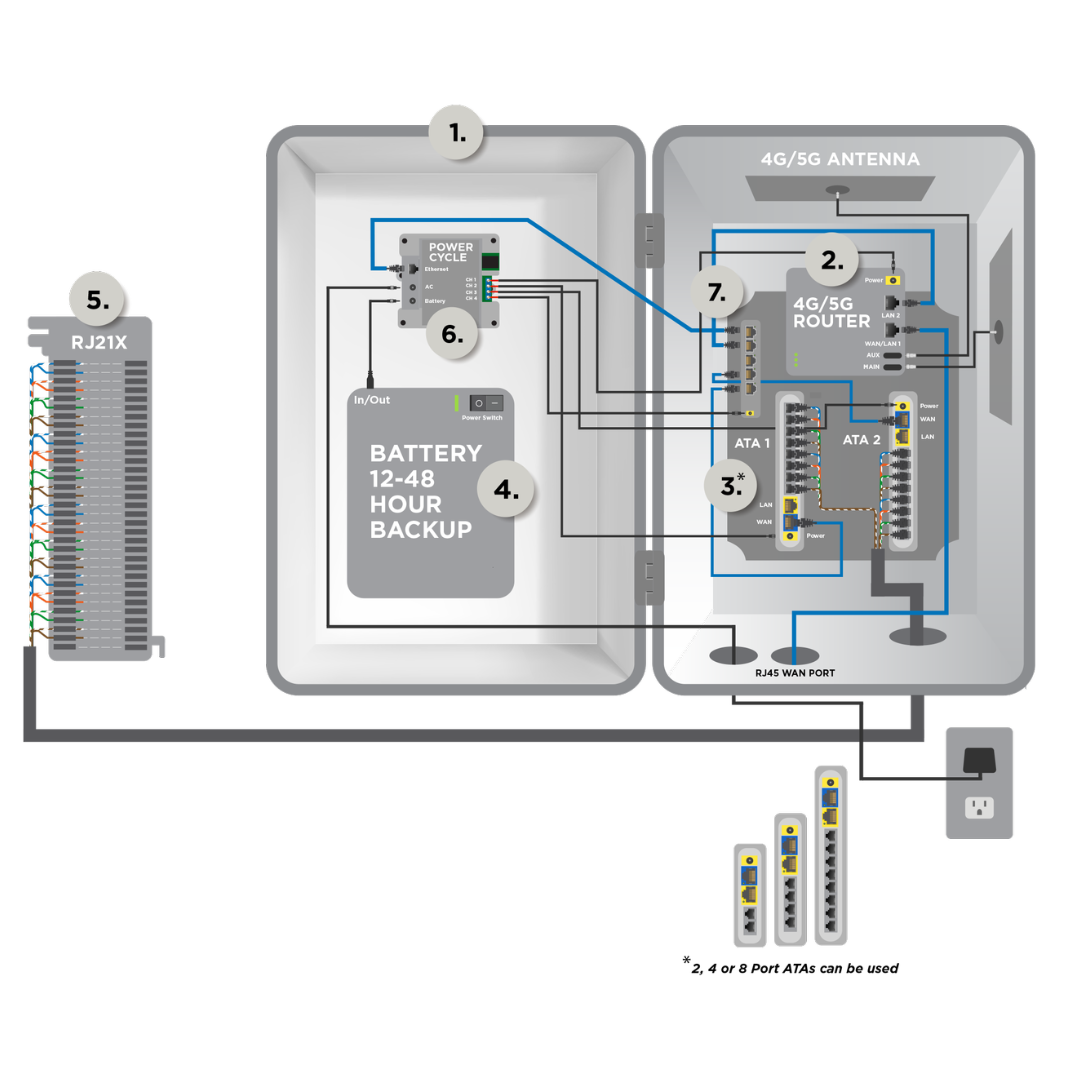POTS Line Replacement
by ITC Cloud.
Reduce the costs of your expensive POTS Lines by moving to the cloud and see an immediate reduction in phone expenses and maintenance costs.
Prepare Your Business for The Move Away from Copper POTS Lines
With POTS Line Replacement by ITC Cloud, you get the hardware, data, and phone service you need without the expensive maintenance costs associated with POTS Lines. Plus, regulatory compliance is built in, so you know your alarms, essential lines, and access control systems will continue to function.
Our Next Generation Managed POTS Line Service is a code-compliant, comprehensive solution that directly replaces traditional copper POTS lines. All equipment is carrier-grade, and is UL Listed to deliver future-proofed telephone services.
Immediate Cost Savings
Reduce your expenses by as much as 70% compared to POTS Lines by moving to the cloud.
Reliability & Uptime
Powered by high speed data, your always on connection can be relied on even during outages.
Predictable Pricing
Avoid increasing POTS Lines rates with stable pricing and fixed cost plans that won't surprise you each month.
Works With Your Systems
Reduce your network complexity and keep using your existing equipment, the transition is easy.
Reduce Maintenance
Stop worrying about aging copper lines, out of date phones, and line repair/replacement costs.
Fully Compliant
Maintain compliance with fire, e911, and safety services with wireless failover for crucial systems.
Ready to Make The Switch from POTS Lines?

More Features,
Better Service.
POTS Replacement means moving to the cloud, which brings all of the additional benefits you’d expect from a cloud phone system.
Easily Manage Your Network & Users
In-Depth Reporting on Call Activity
Increase Flexibility of Your Workforce
Optimize Your Usage & Resources
POTS Replacement
Equipment
Our next generation POTS Line replacement equipment features cutting edge hardware to exceed performance standards, and help you prepare for the future as technologies evolve.
Secure Enclosure
NEMA Telco Enclosure -11"L x 7"W x 7"H
4G/5G Routers
Industry Leading Cellular Router - 4G or 5G
Multiple Available ATAs
Up to 2 ATAs - Supporting up to 16 Lines
Powerful Backup Battery
Mini UPS | 10.4 Ah | Uninterrupted Power Supply 24-48 Hours of Back Up Power
RJ31X Code Compliance DMARC
66 Block, Code Compliant DMARC for POTS Line Delivery - 10"L x 3"W x 7"H
Remote Power Cycling
Remote reboot device with support for 4 channels, battery health monitor
POTS Line Compliance Models
At risk industries require special considerations, ensuring that no communication is lost due to line damage or other acts of nature. We offer multiple solutions to ensure regulatory compliance, and a secured end-to-end connection.

Secure, Private End-to-End Connection

POTS Line Applications
Maintain compliance and ensure effective communication with next-generation POTS Line replacements. From fire alarms to elevators, our POTS Line replacement solutions keep your applications in communication.
Voice
Fire Alarms
Security Alarms
Elevators
Fax Lines
Modems
Call Boxes
POS Systems
Paging Systems
Access Control
Panic Buttons
Meter Reading
ATMs
Vending Machines
SCADA Application Phone System
Backups
Data Connection Backup
What to Know About POTS Line Replacement
A POTS (Plain Old Telephone Service) line, a landline, is a traditional analog telephone connection that utilizes copper wires to transmit voice signals between a telephone device and the telephone network.
POTS lines have been a standard means of communication for decades and are characterized by their reliability and ability to function even during power outages. While they have become less common in recent years due to the prevalence of digital and internet-based communication technologies, POTS lines are still used in some areas and for specific applications where a dependable voice connection is essential.
Traditional Plain Old Telephone Service (POTS) is on its way out. Telecom providers are phasing out POTS lines, and it’s only a matter of time before they become obsolete.
The FCC order 19-72A1 was issued in August 2019, permitting telecom providers to move away from outdated, expensive to maintain, degrading copper POTS lines. The move away from the older infrastructure, of course, requires a replacement (by law). Instead, providers are moving their customers to the cloud.
POTS lines, or Plain Old Telephone Service lines, serve a variety of essential purposes, making them valuable in specific applications where reliable communication is critical:
• Fire Alarm: POTS lines are used for fire alarm systems, ensuring prompt notification to emergency services in case of a fire.
• Security Alarm: Security systems rely on POTS lines to report intrusions and breaches to monitoring centers.
• Voice: Traditional voice calls are made over POTS lines for residential and business telephony.
• Elevator: Elevator emergency phones and communication systems often use POTS lines for emergency contact.
• Fax: Fax machines still utilize POTS lines for transmitting documents.
• Blue Light: Emergency blue light phones on college campuses and public areas often connect through POTS lines.
• Point of Sale: POTS lines can facilitate transaction processing in retail environments.
• Security Gate Door Access: Entry systems and security gates can communicate through POTS lines to grant access.
• Panic Buttons: Panic buttons and alarm systems in public places can be connected via POTS lines to alert authorities.
• Meter Reading: Utility companies may use POTS lines to remotely read meters and monitor usage.
• Modems: Dial-up modems for internet access use POTS lines, though this technology is becoming less common.
• Out of Band Management: POTS lines are used for remote management and maintenance of network equipment.
• SCADA Applications: Supervisory Control and Data Acquisition systems use POTS lines to monitor and control industrial processes.
• Internet Backup: POTS lines can serve as a backup for internet connectivity in case of network failures, ensuring continuous online access.
Several POTS (Plain Old Telephone Service) line replacement options are available, offering more advanced and versatile communication solutions:
VoIP (Voice over IP): VoIP services transmit voice data over the internet, providing cost-effective and feature-rich alternatives to traditional POTS lines.
Fiber-Optic Internet: Fiber-optic networks offer high-speed internet access and can be used for digital voice services.
Cellular Services: Cellular networks provide wireless communication options, including cellular voice services and wireless modems for data connectivity.
Satellite Communication: Satellite phones and internet services offer reliable communication in remote areas where other options may not be available.
SIP Trunking: Session Initiation Protocol (SIP) trunking allows businesses to connect their phone systems to the internet for voice communication.
Wireless LAN (Wi-Fi): Wi-Fi networks can be used for voice and data communication within homes and businesses, especially when integrated with VoIP services.
4G/5G Wireless: High-speed mobile networks like 4G and 5G can serve as backup or primary communication options, including voice and data services.
Cloud-Based Phone Systems: Cloud-based phone systems, also known as hosted PBX, offer advanced features and flexibility for businesses, replacing traditional PBX systems and POTS lines.
The choice of POTS line replacement option depends on factors like location, budget, desired features, and specific communication needs.
The timeline for the complete phase-out of POTS (Plain Old Telephone Service) lines varies by region and telecom provider. However, the obligation to continue supporting traditional copper POTS Lines ended on August 2, 2022. POTS lines have been in decline for years due to the rapid adoption of digital and internet-based communication technologies. In many areas, traditional POTS services are no longer actively marketed or maintained, and telecom companies are shifting their investments towards more modern infrastructure.
The complete discontinuation of POTS lines may take several more years or even decades, as some regions and organizations still rely on them for essential services, including emergency communications. Additionally, regulatory factors and the need to ensure that alternative communication options are universally accessible will influence the timeline for the phase-out of POTS lines.
Ultimately, the transition away from POTS lines will be gradual and dependent on a combination of technological advancements, market demand, and regulatory decisions. It is difficult to pinpoint a specific date for their complete disappearance, but their usage will continue to decline over time.
• Connectivity: Broadband, 4G LTE, 5G, Wi-Fi
• Optional Primary Cellular Connectivity
• Multi-SIM, Multi-Carrier Connectivity Options
• Up to 16 POTS Lines per Equipment Enclosure
• Up to 48 hours of Emergency Battery Backup Power
• RJ21X DEMARC (66-Block)
• NFPA 72 Code Compliant
• UL 60950-1, UL 62368-1, and UL 2054 listings
Ready to Replace Your POTS Lines?
Shoot us a message today to schedule a consultation with our team and discuss how we can help you reduce monthly expenses.


